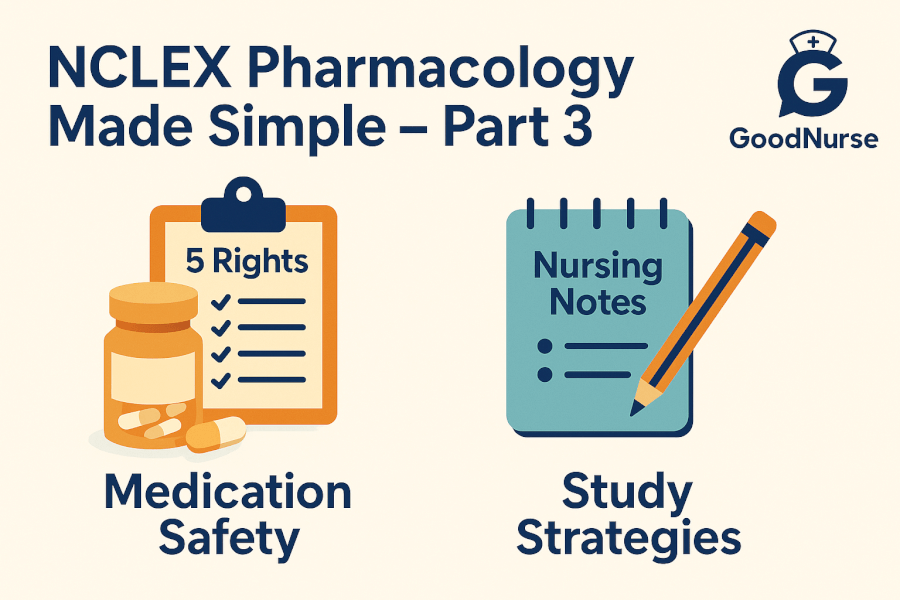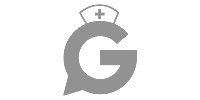This is a 3 part series on Pharmacology made simple for the NCLEX, did you miss the first two parts?
Catch up with NCLEX Pharmacology Made Simple — Part 1: Core Principles & Pharmacokinetics/Pharmacodynamics and
Part 2: Drug‑Dosage Calculations & High‑Yield Classifications.
IV. High‑Yield NCLEX Drug Classifications (continued)
C. Pain‑Management Drugs
1. Opioids (Narcotic Analgesics)
Examples – morphine, fentanyl, hydromorphone, oxycodone
MOA – bind to opioid receptors in the CNS, altering pain perception
Indications – moderate‑to‑severe pain
| Critical Side‑Effects | Essential Nursing Alerts |
|---|---|
| NCLEX Alert • Respiratory depression Sedation, hypotension, constipation, nausea |
Monitor RR (hold < 10–12 /min) & LOC • Keep naloxone available • Prevent & manage constipation • Fall precautions |
Mnemonic: MORPHINE → Miosis, Out‑of‑it, Respiratory‑depression, …
2. NSAIDs
Examples – ibuprofen, naproxen, ketorolac, aspirin
MOA – inhibit COX‑1/COX‑2 → ↓ prostaglandins
Indications – mild‑to‑moderate pain, inflammation, fever (aspirin also antiplatelet)
| Critical Side‑Effects | Nursing Alerts |
|---|---|
| NCLEX Alert • GI irritation / ulcers / bleeding • Nephrotoxicity • ↑ bleeding risk | Give with food or milk • Monitor for GI bleed • Caution with ulcer hx & renal disease • Limit ketorolac to 5 days |
3. Acetaminophen
MOA – analgesic & antipyretic (weak anti‑inflammatory)
Indications – mild pain, fever
| Critical Side‑Effect | Nursing Alerts |
|---|---|
| NCLEX Alert • Hepatotoxicity with overdose | Max 4 g / day (all sources) • Antidote = acetylcysteine • Teach patients to read OTC labels |
D. Psychotropic Medications
Note: Many antidepressants can increase suicidal ideation early in therapy.
1. SSRIs (Selective Serotonin Re‑uptake Inhibitors)
Examples – fluoxetine, sertraline, escitalopram
MOA – block serotonin re‑uptake → ↑ serotonin levels
Indications – depression, anxiety disorders
| Critical Side‑Effects | Nursing Alerts |
|---|---|
| GI upset • Sexual dysfunction • NCLEX Alert • Serotonin Syndrome (agitation, fever, tremor, rigidity) | Takes 2–4 weeks for effect • Don’t stop abruptly • Watch for serotonin syndrome & suicidality • Avoid MAOIs (wash‑out gap needed) |
Turn tricky drug facts into unforgettable memory hooks!
Explore our complete collection of
Nursing Pharmacology Mnemonics — A Complete Guide
and give your brain a shortcut on exam day.
2. Benzodiazepines
Examples – lorazepam, diazepam, alprazolam
MOA – enhance GABA → sedation, anxiolysis, muscle relaxation
Indications – anxiety, insomnia, seizures, alcohol withdrawal
| Critical Side‑Effects | Nursing Alerts |
|---|---|
| CNS/respiratory depression • NCLEX Alert • tolerance, dependence, withdrawal | Monitor LOC, RR, BP • Fall precautions • Avoid alcohol/CNS depressants • Antidote = flumazenil • Taper gradually |
3. Antipsychotics
| Type | Examples | Key NCLEX Concerns |
|---|---|---|
| Typical (FGA) | haloperidol, chlorpromazine | NCLEX Alert • EPS (dystonia, akathisia, parkinsonism, TD) • NMS |
| Atypical (SGA) | risperidone, olanzapine, clozapine | NCLEX Alert • Metabolic syndrome • Clozapine → agranulocytosis |
General nursing: monitor for EPS, TD, NMS; for SGAs track weight, glucose, lipids; clozapine needs regular WBC counts.
E. Endocrine Medications
1. Insulins
| Type | Example | Onset / Peak / Notes | NCLEX Nuggets |
|---|---|---|---|
| Rapid | Lispro | 10‑30 min / 30 min–3 h | Give right before meals |
| Short | Regular | 30‑60 min / 2‑5 h | Only IV insulin |
| Intermediate | NPH | 1.5‑4 h / 4‑12 h | Cloudy; roll to mix |
| Long | Glargine | 0.8‑4 h / none | No mixing; 24 h basal |
NCLEX Alert • Hypoglycemia (BG < 70 mg/dL)
Nursing: check BG before dose, ensure food for peaks, treat lows via “Rule of 15”, rotate sites, draw clear before cloudy when mixing.
Table – High‑Yield Drug Classes & Must‑Do Alerts
| Class | Key Side‑Effects | Absolute Must‑Do |
|---|---|---|
| ACE Inhibitors (‑pril) | Angioedema, Cough, ↑ K⁺ | Monitor BP & K⁺, watch for angioedema, avoid in pregnancy |
| Beta‑Blockers (‑olol) | Bradycardia, Bronchospasm | Hold HR < 60, caution in asthma, taper off |
| Loop Diuretics (‑semide) | Hypokalemia, Ototoxicity | Check K⁺ & fluid status, slow IV push |
| Warfarin | Bleeding | Monitor INR, give vitamin K if needed |
| Heparin / LMWH (‑parin) | Bleeding, HIT | Monitor aPTT (IV), protamine antidote |
| Aminoglycosides | Nephro‑ & ototoxicity | Peak/trough, renal & hearing checks |
| Fluoroquinolones (‑floxacin) | Tendon rupture, Photosensitivity | Report tendon pain, avoid sun |
| Opioids | Respiratory depression | Monitor RR & LOC, naloxone on hand |
| SSRIs | Serotonin syndrome | Watch for agitation/fever, avoid MAOIs |
| Benzos (‑azepam/‑azolam) | Resp. depression, dependence | Monitor RR, antidote flumazenil |
🥇Voted #1 Nursing Study Tool.
Personalized AI Tutor + Instant Answers to All Your Questions. 100% Money Back Guarantee!
🥇Voted #1 Nursing Study Tool.
Personalized AI Tutor + Instant Answers to All Your Questions. 100% Money Back Guarantee!
V. Medication Safety: A Non‑Negotiable for NCLEX and Practice
The “Rights” of Medication Administration
- Right Patient (2 identifiers)
- Right Drug (3 label checks)
- Right Dose (verify & calculate)
- Right Route
- Right Time
- Right Documentation
(+ Right Reason • Response • Refuse • Education)
Preventing Errors
- Three label checks • Minimise distractions
- Clarify unclear orders • Beware LASA drugs
- Engage patients with education & reconciliation
Therapeutic Drug‑Level Monitoring (narrow TI)
| Drug | Range | Toxicity Signs |
|---|---|---|
| Digoxin | 0.8–2 ng/mL | N/V, halos, bradycardia |
| Lithium | 0.8–1.2 mEq/L | Tremor, N/V, confusion |
| Phenytoin | 10–20 mcg/mL | Nystagmus, ataxia |
| Gentamicin | Peak 5–10 mcg/mL • Trough < 2 | Nephro/ototoxicity |
| Vancomycin | Trough 10–20 mcg/mL | Nephro/ototoxicity |
Pregnancy Categories & Controlled‑Substance Schedules
- Pregnancy (old system): A → X (X = contraindicated)
- DEA Schedules: I (no medical use) → V (lowest abuse)
VI. Smart Study Strategies for NCLEX Pharmacology Domination
| Technique | How to Use |
|---|---|
| Mnemonics | Make them personal & vivid |
| Flashcards | Include drug class, MOA, indications, side‑effects, nursing alerts |
| Practice Qs | Focus on rationales; use GoodNurse question bank |
| Spaced Repetition | Review at increasing intervals |
| Active Recall | Quiz yourself, teach others |
| High‑Yield Focus | Prototype drugs, narrow‑TI meds, common NCLEX traps |
| Trusted Resources | Textbooks, GoodNurse articles, GoodNurse AI tutor |
Debunk NCLEX study myths → NCLEX Myths Busted
Explore AI study aids → https://goodnurse.com/articles/AI%20in%20Nursing
VII. Conclusion: You Can Conquer NCLEX Pharmacology!
Pharmacology mastery demands effort, but armed with the principles, calculations, high‑yield drug facts, safety pearls, and smart study tactics from Parts 1‑3, you’re on track to excel.
Next steps
- Work the GoodNurse practice‑question bank and AI tutor for personalised feedback.
- Dive into focused cluster articles (cardio, antibiotics, psych, endocrine, IV math, etc.) to deepen weak areas.
- Keep patient safety at the centre of every calculation and drug decision—you’ll carry that habit into practice.
This completes our three‑part NCLEX pharmacology series.
Revisit the earlier installments any time:
- Part 1 — Core Pharmacokinetics, Pharmacodynamics & Key Concepts
- Part 2 — Drug‑Dosage Calculations & High‑Yield Classifications
You’ve got this—see you on the NCLEX pass list!






